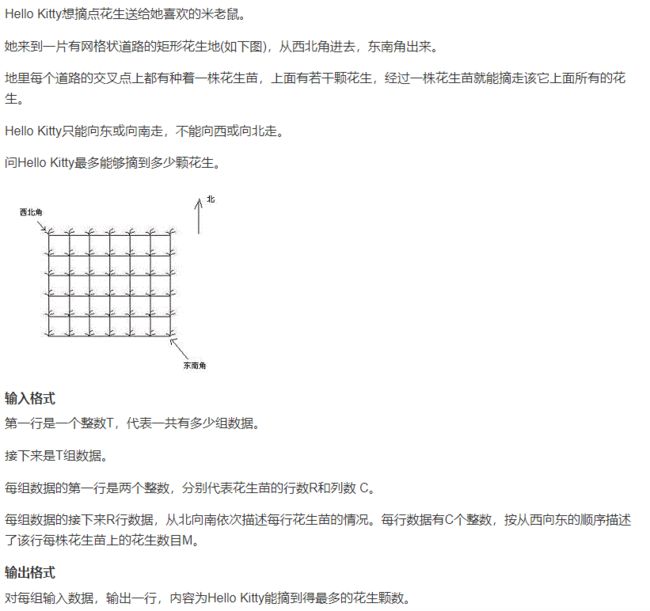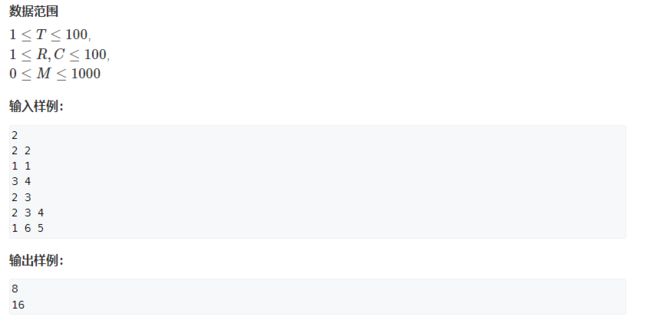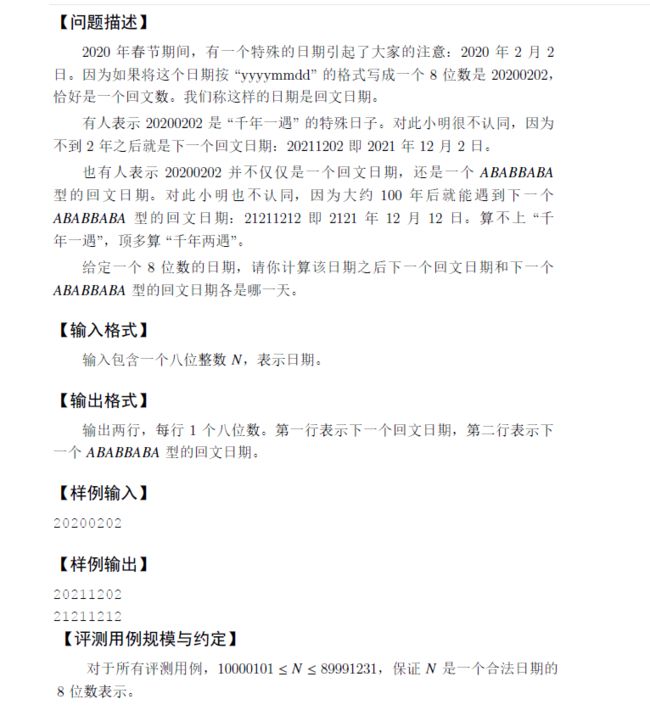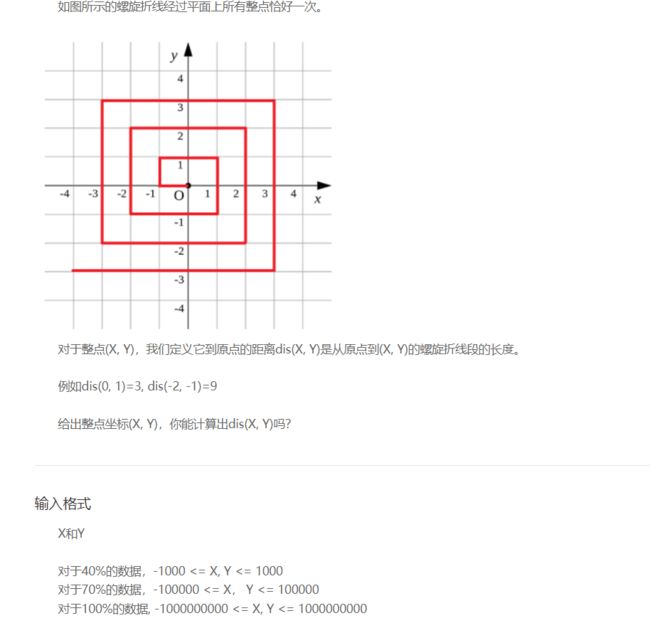【算法练习】蓝桥杯C++ AB组辅导课题单:第三、四、五讲(Java解答版)
带※的题目,代表值得二刷、三刷、多刷!
蓝桥杯C++ AB组辅导课提单(Java解答版)
-
-
- 一、数学与简单DP
-
- ※1205、买不到的数目(简单)(互质两数不能凑出的最大数)
- 1211、蚂蚁感冒(简单)
- 1216、饮料换购(简单)
- 2、01背包问题(简单)
- 1015、摘花生(简单)
- 895、最长上升子序列(简单)
- ※1212、地宫取宝(中等)(DP)
- ※1214、波动数列(中等)(DP)
- 二、枚举、模拟与排序
-
- 1210、连号区间数(简单)
- 1236、递增三元组(中等)
- 1245、特别数的和(简单)
- 1204、错误票据(简单)
- 466、回文日期(简单)
- 787、归并排序(简单)
- 1219、移动距离(简单)
- 1229、日期问题(简单)
- 1231、航班时间(简单)
- 1241、外卖店优先级(简单)
- 788、逆序对的数量(简单)
- 1237、螺旋折线(中等)
- 三、树状数组与线段树
-
- 1264、动态求连续区间和(简单)
- 1265、数星星(中等)
- 1270、数列区间最大值(简单)
- 1215、小朋友排队(简单)
- ~~1228、油漆面积(困难)~~
- ※※1232、三体攻击(困难)
- 797、差分(简单)
- ※798、差分矩阵(简单)
-
一、数学与简单DP
※1205、买不到的数目(简单)(互质两数不能凑出的最大数)

类似于下面这道题:
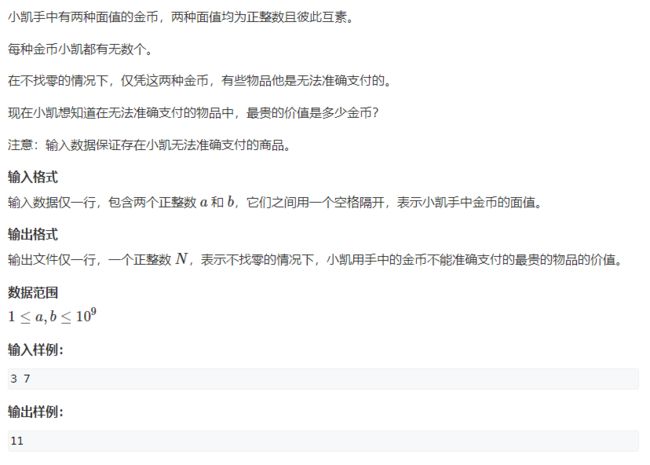
如果知道数学结论很快就可以得出答案:
![]()
也可以通过打表方式找规律。
import java.util.Scanner;
public class Main {
public static void main(String[] args) {
Scanner scan = new Scanner(System.in);
long n = scan.nextLong();
long m = scan.nextLong();
System.out.println(n * m - n - m);
}
}
同理,回到本题,跟上面一样的代码:
import java.util.Scanner;
public class Main {
public static void main(String[] args) {
Scanner scan = new Scanner(System.in);
long n = scan.nextLong();
long m = scan.nextLong();
System.out.println(n * m - n - m);
}
}
数论的题目只能多积累,因为涉及的东西太多了。
1211、蚂蚁感冒(简单)

对于感冒的蚂蚁,不管它向哪边走,如果它的左边有向右走的蚂蚁,或者它的右边有向左走的蚂蚁,它们都可能被感染。所以cnt = left + right + 1(left代表,感染蚂蚁的左边向右走的蚂蚁数,right代表,感染蚂蚁的右边向左走的蚂蚁数,+1是代表感染蚂蚁本身)。
上面的情况只是普遍情况,还要讨论特殊情况,例如:感冒的蚂蚁向左走,但是它左边没有向右的蚂蚁,或者感冒的蚂蚁向右走,但是它右边的蚂蚁没有向左的蚂蚁,那么都不能感染。
import java.util.Scanner;
public class Main {
public static void main(String[] args) {
Scanner scan = new Scanner(System.in);
int n = scan.nextInt();
int[] ants = new int[n];
for (int i = 0; i < n; i++) {
ants[i] = scan.nextInt();
}
// 如果第一个蚂蚁为负值,头朝左
int left = 0;
int right = 0;
for (int i = 1; i < n; i++) {
if (Math.abs(ants[i]) < Math.abs(ants[0])) {
// 在左边,考虑头朝右
if (ants[i] > 0) left++;
} else {
// 在右边,考虑头朝左
if (ants[i] < 0) right++;
}
}
// 考虑特殊情况
if (ants[0] < 0 && left == 0) System.out.println(1);
else if (ants[0] > 0 && right == 0) System.out.println(1);
else System.out.println(left + right + 1);
}
}
1216、饮料换购(简单)
import java.util.Scanner;
public class Main {
public static void main(String[] args) {
Scanner scan = new Scanner(System.in);
int n = scan.nextInt();
int ans = n;
while (n >= 3) {
// 剩下的瓶盖数
int left = n % 3;
// 换购
ans += n / 3;
n = n / 3 + left;
}
System.out.println(ans);
}
}
2、01背包问题(简单)
import java.util.Scanner;
public class Main {
public static void main(String[] args) {
Scanner scan = new Scanner(System.in);
int n = scan.nextInt();
int v = scan.nextInt();
int[] vs = new int[n + 1];
int[] ws = new int[n + 1];
for (int i = 1; i <= n; i++) {
vs[i] = scan.nextInt();
ws[i] = scan.nextInt();
}
// n件物品,v容量的背包
int[][] dp = new int[n + 1][v + 1];
for (int i = 1; i <= n; i++) {
for (int j = 1; j <= v; j++) {
if (j >= vs[i]) {
// 当前物品放得下
dp[i][j] = Math.max(dp[i - 1][j], dp[i - 1][j - vs[i]] + ws[i]);
} else {
// 当前物品放不下
dp[i][j] = dp[i - 1][j];
}
}
}
System.out.println(dp[n][v]);
}
}
1015、摘花生(简单)
import java.util.Scanner;
public class Main {
public static void main(String[] args) {
Scanner scan = new Scanner(System.in);
int t = scan.nextInt();
int[][] penuts;
int[][] dp;
while ((t--) > 0) {
int r = scan.nextInt();
int c = scan.nextInt();
penuts = new int[r][c];
for (int i = 0; i < r; i++) {
for (int j = 0; j < c; j++) {
penuts[i][j] = scan.nextInt();
}
}
// 只能向东向南->向右向下
dp = new int[r][c];
dp[0][0] = penuts[0][0];
// 初始化第一行
for (int i = 1; i < c; i++) {
dp[0][i] = dp[0][i - 1] + penuts[0][i];
}
// 初始化第一列
for (int i = 1; i < r; i++) {
dp[i][0] = dp[i - 1][0] + penuts[i][0];
}
for (int i = 1; i < r; i++) {
for (int j = 1; j < c; j++) {
dp[i][j] = Math.max(dp[i - 1][j], dp[i][j - 1]) + penuts[i][j];
}
}
System.out.println(dp[r - 1][c - 1]);
}
}
}
895、最长上升子序列(简单)
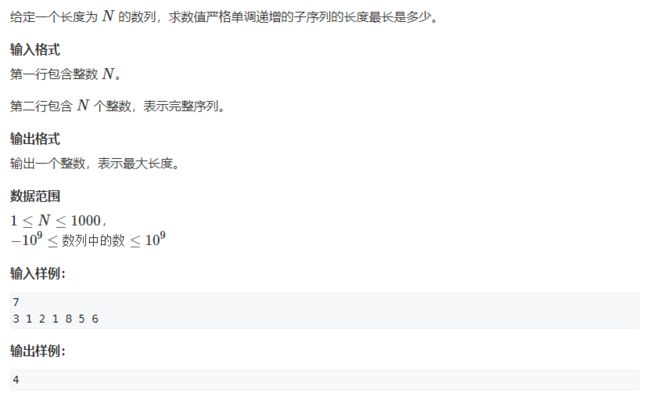
典中典!(可以看看LeetCode的这道题,描述的更详细,会告诉你什么叫做子序列)
import java.util.Scanner;
public class Main {
public static void main(String[] args) {
Scanner scan = new Scanner(System.in);
int n = scan.nextInt();
int[] nums = new int[n];
for (int i = 0; i < n; i++) {
nums[i] = scan.nextInt();
}
// dp[i] 以第i个数结尾的,严格递增的子序列的最大长度
// 子序列:可以删除中间的某些数,但不能改变数的相对位置
int[] dp = new int[n];
dp[0] = 1;
int ans = 1;
for (int i = 1; i < n; i++) {
dp[i] = 1;
// 遍历i之前的数(因为按照dp定义,必须以i结尾)
int max = 1;
for (int j = 0; j <= i; j++) {
if (nums[j] < nums[i]) {
// + 1是代表必须以nums[i]结尾
max = Math.max(dp[j] + 1, max);
}
}
dp[i] = max;
ans = Math.max(ans, dp[i]);
}
System.out.println(ans);
}
}
※1212、地宫取宝(中等)(DP)

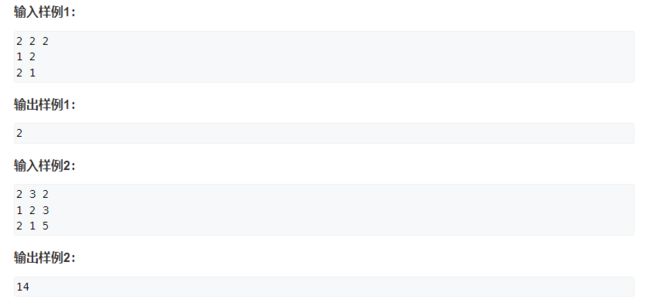
属于是上面两道题的升级版,贴一个y总分析法:
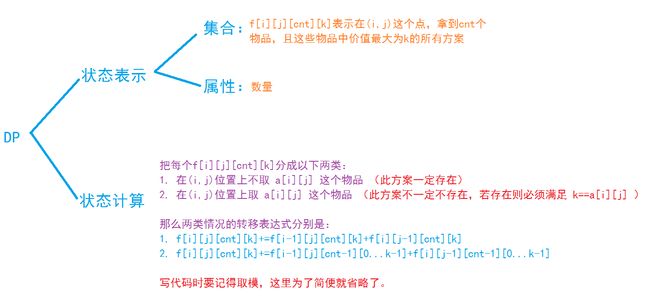
为什么取a[i][j]这个物品,必须要求k==a[i][j]呢?
因为根据题目要求,当前拿到的物品必须大于手中每个物品的价值,那当前取得的物品必须就是最大值,也就是k必须等于a[i][j]
import java.util.Scanner;
public class Main {
static int MOD = 1000000007;
public static void main(String[] args) {
Scanner scan = new Scanner(System.in);
int n = scan.nextInt();
int m = scan.nextInt();
int c = scan.nextInt();
int[][] map = new int[n + 1][m + 1];
int maxVal = 0;
for (int i = 1; i <= n; i++) {
for (int j = 1; j <= m; j++) {
map[i][j] = scan.nextInt();
// 由于宝贝价值可能为0,不方便判断是否拿宝贝,所以全部++
map[i][j]++;
// 求所有宝贝最大价值
maxVal = Math.max(maxVal, map[i][j]);
}
}
// 多了两个状态:手中宝贝数、手中物品最大价值,那就成了4维DP
int[][][][] dp = new int[n + 1][m + 1][c + 1][maxVal + 1];
// dp[i][j][cnt][val],在i,j位置,手中持有cnt件物品,其中最大价值为val的方案数
// 第一个位置有两种情况,拿、不拿
dp[1][1][0][0] = 1;
dp[1][1][1][map[1][1]] = 1;
// 枚举所有情况
for (int i = 1; i <= n; i++) {
for (int j = 1; j <= m; j++) {
for (int cnt = 0; cnt <= c; cnt++) {
// 枚举拿cnt件物品
for (int k = 0; k <= maxVal; k++) {
// 枚举最大价值
// 不拿,它只能从左边或上边转移过来
// 写上加自身是因为dp[1][1][0][0]本身是有值的,并不是=0的
// 而又无法避免cnt必须从0开始遍历,所以只能是自加
dp[i][j][cnt][k] = (dp[i][j][cnt][k] + dp[i - 1][j][cnt][k]) % MOD;
dp[i][j][cnt][k] = (dp[i][j][cnt][k] + dp[i][j - 1][cnt][k]) % MOD;
// 拿商品,那cnt必须 >0,且最大价值k就是当前物品自身
if (cnt > 0 && k == map[i][j]) {
// 遍历所有之前可能的最大价值,都可能转移过来
for (int s = 0; s < map[i][j]; s++) {
dp[i][j][cnt][k] = (dp[i][j][cnt][k] + dp[i - 1][j][cnt - 1][s]) % MOD;
dp[i][j][cnt][k] = (dp[i][j][cnt][k] + dp[i][j - 1][cnt - 1][s]) % MOD;
}
}
}
}
}
}
// 最后统计所有拿了c个物品的,但物品的最大价值不确定的所有方案数
int res = 0;
for (int i = 1; i <= maxVal; i++) {
res = (res + dp[n][m][c][i]) % MOD;
}
System.out.println(res);
}
}
※1214、波动数列(中等)(DP)
扩展知识:负余数转正余数
int getMod(int a, int b) {
return (a % b + b) % b;
}

最不好理解的就是这里的转换:x为任意整数,所以得出,第一个数s,与后面n-1个数根据a、b操作组成的序列和模n的余数相同。
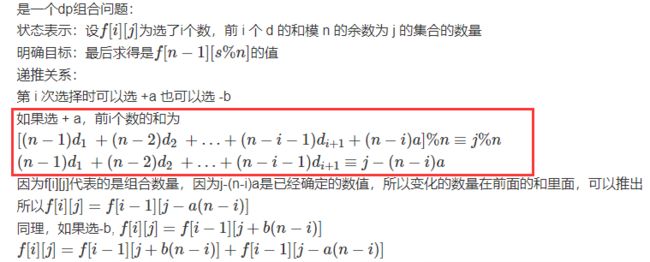
上面的转移方程还不够,因为我们要找与第一个数s同余,且长度为n-1的方案数,所以对j + b(n-i)、j - a(n-i)都要对n取余,因为题目中的数据可能为负数,但是数组index没法为负,就需要把负余数转成正余数,就是用上面的方法。最终答案就是:f[n - 1][s % n],当然这里的s % n也得用正余数。
import java.util.Scanner;
public class Main {
static int MOD = 100000007;
static int getMod(int a, int b) {
return (a % b + b) % b;
}
public static void main(String[] args) {
Scanner scan = new Scanner(System.in);
int n = scan.nextInt();
int s = scan.nextInt();
int a = scan.nextInt();
int b = scan.nextInt();
int[][] dp = new int[n][n];
// dp[i][j]选了i个数,前 i 个 d 的和模 n 的余数为 j 的集合的数量
// 这个d可以是+a、-b
dp[0][0] = 1;
// 一个数没选,模n为0的方案数=1
for (int i = 1; i < n; i++) {
for (int j = 0; j < n; j++) {
dp[i][j] = (dp[i - 1][getMod(j + b * (n - i), n)] + dp[i - 1][getMod(j - a * (n - i), n)]) % MOD;
}
}
System.out.println(dp[n - 1][getMod(s, n)]);
}
}
二、枚举、模拟与排序
这类题目是非常值得练手的题目,可以帮助自己写代码的时候更加细心仔细
1210、连号区间数(简单)
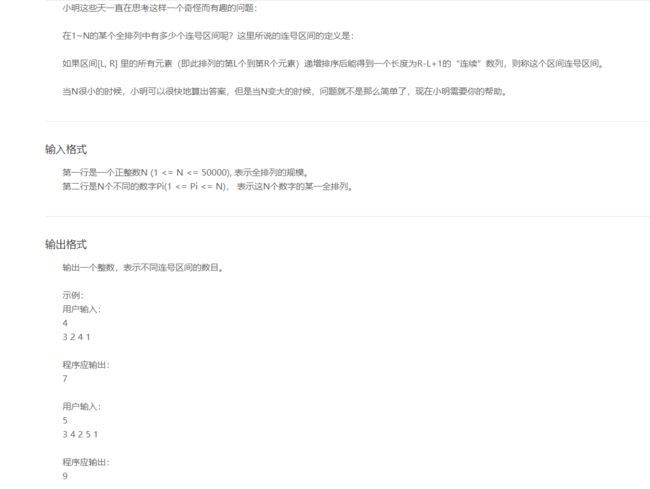
注意要满足长度为R-L+1的连续数列,也就是说:最大值-最小值,等于左右下标之差,抓住这个关键信息就可以很快拿下。
import java.util.*;
public class Main {
public static void main(String[] args) {
Scanner scan = new Scanner(System.in);
int n = scan.nextInt();
int[] num = new int[n];
for (int i = 0; i < n; i++) {
num[i] = scan.nextInt();
}
// 每个数字和自己都可以组成
int ans = n;
for (int i = 0; i < n; i++) {
int max = num[i];
int min = num[i];
for (int j = i + 1; j < n; j++) {
max = Math.max(max, num[j]);
min = Math.min(min, num[j]);
if (max - min == j - i) ans++;
}
}
System.out.println(ans);
}
}
1236、递增三元组(中等)


我们去枚举中间数,找A数组中有多少数小于当前数,找B数组中有多少数大于当前数即可。
import java.util.*;
public class Main {
public static void main(String[] args) {
Scanner scan = new Scanner(System.in);
int n = scan.nextInt();
int[] A = new int[n];
int[] B = new int[n];
int[] C = new int[n];
for (int i = 0; i < n; i++) A[i] = scan.nextInt();
for (int i = 0; i < n; i++) B[i] = scan.nextInt();
for (int i = 0; i < n; i++) C[i] = scan.nextInt();
long ans = 0;
int p = 0, q = 0;
// 需要注意,排序并不改变最终结果
Arrays.sort(A);
Arrays.sort(B);
Arrays.sort(C);
for (int i = 0; i < n; i++) {
// 找A前面有多少数小于Bi
while (p < n && A[p] < B[i]) p++;
// 找B后面第一个大于Bi的位置,这样后面大于Bi的数就有n - q
while (q < n && C[q] <= B[i]) q++;
ans += (long)(p * (n - q));
}
System.out.println(ans);
}
}
1245、特别数的和(简单)
import java.util.*;
public class Main {
public static void main(String[] args) {
Scanner scan = new Scanner(System.in);
int n = scan.nextInt();
long ans = 0;
for (int i = 1; i <= n; i++) {
if (check(i)) ans += i;
}
System.out.println(ans);
}
static boolean check(int x) {
while (x != 0) {
int t = x % 10;
x /= 10;
if (t == 2 || t == 0 || t == 1 || t == 9) return true;
}
return false;
}
}
1204、错误票据(简单)
import java.io.BufferedReader;
import java.io.IOException;
import java.io.InputStreamReader;
import java.util.*;
public class Main {
static BufferedReader reader = new BufferedReader(new InputStreamReader(System.in));
public static void main(String[] args) throws IOException {
String[] input = reader.readLine().trim().split(" ");
int n = Integer.parseInt(input[0]);
int[] id = new int[10010];
int idx = 0;
while (n-- > 0) {
input = reader.readLine().trim().split(" ");
int len = input.length;
for (int i = 0; i < len; i++) {
id[idx++] = Integer.parseInt(input[i]);
}
}
Arrays.sort(id, 0, idx);
int mm = -1;
int nn = -1;
for (int i = 0; i < idx; i++) {
if (i > 0 && id[i] == id[i - 1]) {
// 重号
nn = id[i];
} else if (i > 0 && id[i] != id[i - 1] + 1){
mm = id[i - 1] + 1; // 缺号
}
}
System.out.println(mm + " " + nn);
}
}
466、回文日期(简单)
import java.io.*;
import java.util.*;
import javax.swing.text.AbstractDocument.LeafElement;
public class Main {
static BufferedReader reader = new BufferedReader(new InputStreamReader(System.in));
public static void main(String[] args) throws IOException {
Scanner scan = new Scanner(System.in);
int n = scan.nextInt();
int year = n / 10000;
int day = n % 100;
int month = (n - year * 10000) / 100;
// 先找下一个回文日期,再找下一个ABABBABA型回文日期
// 如果闰年2月再加1天
int[] M = new int[] {0, 31, 28, 31, 30, 31, 30, 31, 31, 30, 31, 30, 31};
boolean flag1 = false;
boolean flag2 = false;
String ans1 = "";
String ans2 = "";
while (true) {
// 从day开始更新日期
day++;
if (month == 2) {
if (isLeap(year) && day > 29) {
month++;
day = 1;
}
if (!isLeap(year) && day > 28) {
month++;
day = 1;
}
} else {
if (day > M[month]) {
month++;
day = 1;
}
}
if (month > 12) {
month = 1;
year++;
}
StringBuilder sb = new StringBuilder();
sb.append(year);
if (month < 10) {
sb.append(0).append(month);
} else {
sb.append(month);
}
if (day < 10) {
sb.append(0).append(day);
} else {
sb.append(day);
}
if (check(sb.toString()) && flag1 == false) {
flag1 = true;
ans1 = sb.toString();
}
if (check1(sb.toString()) && flag2 == false) {
flag2 = true;
ans2 = sb.toString();
}
// 两个都找到了在输出
if (flag1 && flag2) break;
}
System.out.println(ans1);
System.out.println(ans2);
}
// 判断闰年
static boolean isLeap(int year) {
if ((year % 4 == 0 && year % 100 != 0) || year % 400 == 0) return true;
return false;
}
// 判断普通回文日期
static boolean check(String str) {
int i = 0;
int j = str.length() - 1;
while (i <= j) {
if (str.charAt(i) != str.charAt(j)) return false;
i++;
j--;
}
return true;
}
// 判断ABABBABA型回文日期
static boolean check1(String str) {
char A = str.charAt(0);
char B = str.charAt(1);
if (str.charAt(2) == A && str.charAt(3) == B && str.charAt(4) == B && str.charAt(5) == A && str.charAt(6) == B && str.charAt(7) == A) {
return true;
}
return false;
}
}
787、归并排序(简单)
实现归并排序
import java.io.*;
import java.util.*;
public class Main {
static BufferedReader reader = new BufferedReader(new InputStreamReader(System.in));
public static void main(String[] args) throws IOException {
Scanner scan = new Scanner(System.in);
int n = scan.nextInt();
int[] nums = new int[n];
for (int i = 0; i < n; i++) nums[i] = scan.nextInt();
// 辅助数组
int[] tmp = new int[n];
mergeSort(nums, tmp, 0, n - 1);
System.out.println(Arrays.toString(nums));
}
static void mergeSort(int[] nums, int[] tmp, int left, int right) {
if (left < right) {
int mid = left + (right - left) / 2;
mergeSort(nums, tmp, left, mid);
mergeSort(nums, tmp, mid + 1, right);
merge(nums, tmp, left, mid, right);
}
}
static void merge(int[] nums, int[] tmp, int left, int mid, int right) {
int i = left;
int j = mid + 1;
int k = 0;
// i是前半部分数组的开始下标,j是后半部分数组的开始下表,k是新的数组的下标
while (i <= mid && j <= right) {
if (nums[i] <= nums[j]) {
// 用<=保证排序的稳定性
tmp[k++] = nums[i++];
} else {
tmp[k++] = nums[j++];
}
}
// 可能前一半数组没放完,也可能后一半数组没放完
while (i <= mid) {
tmp[k++] = nums[i++];
}
while (j < mid) {
tmp[k++] = nums[j++];
}
// 将tmp中数组元素合并到nums
for (int t = 0; t < k; t++) {
nums[t + left] = tmp[t];
}
}
}
1219、移动距离(简单)
import java.io.*;
import java.util.*;
public class Main {
static BufferedReader reader = new BufferedReader(new InputStreamReader(System.in));
public static void main(String[] args) throws IOException {
Scanner scan = new Scanner(System.in);
int w = scan.nextInt();
int m = scan.nextInt();
int n = scan.nextInt();
m--;n--;
int x1 = m / w;
int x2 = n / w;
int y1 = m % w;
int y2 = n % w;
if (x1 % 2 == 1) {
// 如果是奇数行
y1 = w - y1 - 1;
}
if (x2 % 2 == 1) {
// 如果是奇数行
y2 = w - y2 - 1;
}
System.out.println(Math.abs(x1 - x2) + Math.abs(y1 - y2));
}
}
1229、日期问题(简单)
import java.io.*;
import java.util.*;
public class Main {
static BufferedReader reader = new BufferedReader(new InputStreamReader(System.in));
public static void main(String[] args) throws IOException {
String[] input = reader.readLine().trim().split("/");
// 年月日 月日年 日月年,年份忽略了前两位
// 保证每次取出来都是年月日
int[] date = new int[3];
for (int i = 0; i < 3; i++) {
date[i] = Integer.parseInt(input[i]);
}
int[][] chance = new int[][] {{0,1,2},{2,0,1},{2,1,0}};
int[] M = new int[] {0,31,28,31,30,31,30,31,31,30,31,30,31};
List<String> ans = new LinkedList<>();
for (int i = 0; i < 3; i++) {
int year = date[chance[i][0]];
int month = date[chance[i][1]];
int day = date[chance[i][2]];
StringBuilder sb = new StringBuilder();
if (year <= 59) {
if (year < 10) {
sb.append("200").append(year);
} else {
sb.append("20").append(year);
}
} else {
sb.append("19").append(year);
}
if (month < 1 || month > 12) continue;
if (month < 10) sb.append("-0").append(month);
else sb.append("-" + month);
if (day < 1) continue;
int t = 0;
if (isLeap(year)) {
if (month == 2) t = 29;
else t = M[month];
} else {
t = M[month];
}
if (day > t) continue;
if (day < 10) sb.append("-0").append(day);
else sb.append("-" + day);
ans.add(sb.toString());
}
Collections.sort(ans);
// 结果可能有重复,要去重
for (int i = 0; i < ans.size(); i++) {
if (i > 0 && ans.get(i).equals(ans.get(i - 1))) continue;
System.out.println(ans.get(i));
}
}
static boolean isLeap(int year) {
if ((year % 4 == 0 && year % 100 != 0) || year % 400 == 0) {
return true;
}
return false;
}
}
1231、航班时间(简单)


因为不知道时差是多少,只知道在出发地的出发时间,已经目标地的到达时间,我们可以将两次的空中飞行时间相加再求平均值,最终结果就是答案。

图源:https://blog.csdn.net/Cyril_KI/article/details/107372908?spm=1001.2101.3001.6650.2&utm_medium=distribute.pc_relevant.none-task-blog-2%7Edefault%7ECTRLIST%7ERate-2.pc_relevant_antiscanv2&depth_1-utm_source=distribute.pc_relevant.none-task-blog-2%7Edefault%7ECTRLIST%7ERate-2.pc_relevant_antiscanv2&utm_relevant_index=5
转换成秒之后再去算时间差更方便
import java.io.*;
import java.util.*;
public class Main {
static BufferedReader reader = new BufferedReader(new InputStreamReader(System.in));
public static void main(String[] args) throws IOException {
int t = Integer.parseInt(reader.readLine().trim().split(" ")[0]);
while (t-- > 0) {
String[] go = reader.readLine().trim().split(" ");
String[] back = reader.readLine().trim().split(" ");
int len = go.length;
// 把起程时间转成秒
String[] tmp = go[0].split(":");
int start = Integer.parseInt(tmp[0]) * 3600 + Integer.parseInt(tmp[1]) * 60 + Integer.parseInt(tmp[2]);
int aver = 0;
int end = 0;
tmp = go[1].split(":");
end = Integer.parseInt(tmp[0]) * 3600 + Integer.parseInt(tmp[1]) * 60 + Integer.parseInt(tmp[2]);
if (len == 3) {
// 有 +1、+2
int num = go[2].charAt(2) - '0';
if (num == 1) {
end += 24 * 3600;
} else {
end += 48 * 3600;
}
}
aver = end - start;
// 再来看回程时间
len = back.length;
tmp = back[0].split(":");
start = Integer.parseInt(tmp[0]) * 3600 + Integer.parseInt(tmp[1]) * 60 + Integer.parseInt(tmp[2]);
tmp = back[1].split(":");
end = Integer.parseInt(tmp[0]) * 3600 + Integer.parseInt(tmp[1]) * 60 + Integer.parseInt(tmp[2]);
if (len == 3) {
// 有 +1、+2
int num = back[2].charAt(2) - '0';
if (num == 1) {
end += 24 * 3600;
} else {
end += 48 * 3600;
}
}
aver += end - start;
aver /= 2;
int second = aver % 60;
int min = aver / 60 % 60;
int hour = aver / 3600;
StringBuilder sb = new StringBuilder();
if (hour < 10) {
sb.append("0").append(hour);
} else {
sb.append(hour);
}
if (min < 10) {
sb.append(":0").append(min);
} else {
sb.append(":" + min);
}
if (second < 10) {
sb.append(":0").append(second);
} else {
sb.append(":" + second);
}
System.out.println(sb.toString());
}
}
}
1241、外卖店优先级(简单)
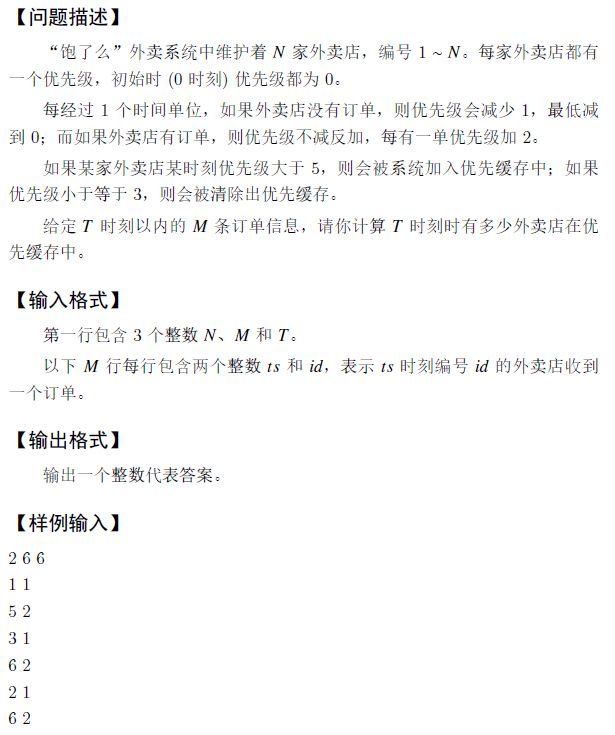

记录每个id对应的订单时间即可,然后枚举每一个id,判断当前id是否能够在T时刻进入优先缓存。
import java.io.*;
import java.util.*;
public class Main {
static BufferedReader reader = new BufferedReader(new InputStreamReader(System.in));
public static void main(String[] args) throws IOException {
String[] input = reader.readLine().trim().split(" ");
int n = Integer.parseInt(input[0]);
int m = Integer.parseInt(input[1]);
int t = Integer.parseInt(input[2]);
// n家外卖店,m条订单信息,计算t时刻有多少外卖店在优先缓存中
HashMap<Integer, LinkedList<Integer>> map = new HashMap<>();
int[] ids = new int[m];
for (int i = 0; i < m; i++) {
input = reader.readLine().trim().split(" ");
int ts = Integer.parseInt(input[0]);
int id = Integer.parseInt(input[1]);
ids[i] = id;
if (!map.containsKey(id)) {
LinkedList<Integer> tmp = new LinkedList<>();
tmp.add(ts);
map.put(id, tmp);
} else {
LinkedList<Integer> tmp = map.get(id);
tmp.add(ts);
map.put(id, tmp);
}
}
// 对id排序方便去重
Arrays.sort(ids);
int ans = 0;
// 先遍历id,再遍历id对应的订单时间
for (int i = 0; i < m; i++) {
// id去重
if (i > 0 && ids[i - 1] == ids[i]) continue;
int id = ids[i];
LinkedList<Integer> time = map.get(id);
int[] cnt = new int[t + 1];
for (int cur : time) {
cnt[cur]++; // 当前时间的订单数+1
}
int prior = 0;
boolean flag = false;
// 遍历所有时间的订单数,时间从1开始
for (int j = 1; j <= t; j++) {
if (cnt[j] == 0) {
if (prior > 0) prior--;
} else {
prior += 2 * cnt[j];
}
if (prior > 5) flag = true;
if (prior <= 3) flag = false;
}
// 在优先缓存中
if (flag) ans++;
}
System.out.println(ans);
}
}
788、逆序对的数量(简单)
是归并排序的扩展题目,在归并排序的过程中实现逆序对数量的统计。
import java.io.*;
import java.util.*;
public class Main {
static BufferedReader reader = new BufferedReader(new InputStreamReader(System.in));
static int ans = 0; // 统计逆序对数量
public static void main(String[] args) throws IOException {
Scanner scan = new Scanner(System.in);
int n = scan.nextInt();
int[] nums = new int[n];
for (int i = 0; i < n; i++) nums[i] = scan.nextInt();
int[] tmp = new int[n];
mergeSort(nums, tmp, 0, n - 1);
System.out.println(Arrays.toString(nums));
System.out.println(ans);
}
static void mergeSort(int[] nums, int[] tmp, int left, int right) {
if (left < right) {
int mid = left + (right - left) / 2;
mergeSort(nums, tmp, left, mid);;
mergeSort(nums, tmp, mid + 1, right);
merge(nums, tmp, left, mid, right);
}
}
static void merge(int[] nums, int[] tmp, int left, int mid, int right) {
// 前半部分的开始下标,右半部分的开始下标,辅助数组的下标
int i = left;
int j = mid + 1;
int k = 0;
while (i <= mid && j <= right) {
if (nums[i] <= nums[j]) {
// 前半部分的值<=后半部分的值,不存在逆序对
tmp[k++] = nums[i++];
} else {
// 此时出现了逆序对,nums[i] > nums[j],说明i后面到mid的数都大于nums[j]
ans += mid - i + 1;
tmp[k++] = nums[j++];
}
}
// 单独剩下的情况就不存在逆序对,前面已经统计过
while (i <= mid) {
tmp[k++] = nums[i++];
}
while (j <= right) {
tmp[k++] = nums[j++];
}
// 把合并结果恢复到nums
for (int t = 0; t < k; t++) {
nums[t + left] = tmp[t];
}
}
}
1237、螺旋折线(中等)
import java.util.*;
public class Main {
public static void main(String[] args) {
Scanner scan = new Scanner(System.in);
long x = scan.nextLong();
long y = scan.nextLong();
// 对于整点(X, Y),我们定义它到原点的距离dis(X, Y)是
// 从原点到(X, Y)的螺旋折线段的长度
long cnt = 0;
if (x >= 0 && y >= 0) {
// 第一象限
if (y >= x) {
// 2,3
cnt = y * y * 4;
cnt = cnt - (y - x);
} else {
// 3,2
cnt = x * x * 4;
cnt = cnt + (x - y);
}
} else if (x >= 0 && y <= 0) {
// 第四象限
if (-y >= x) {
// 2,-3
// 转换成上面的情况
cnt = (-y) * (-y) * 4;
cnt = cnt + (-y) * 2;
cnt = cnt + (-y - x);
} else {
// 3,-2
cnt = x * x * 4;
cnt = cnt + x * 2;
cnt = cnt - (x + y);
}
} else if (x <= 0 && y >= 0) {
// 第二象限
if (-x >= y) {
// -3,2
cnt = (-x) * (-x) * 4;
cnt = cnt - (-x) * 2;
cnt = cnt - (-x - y);
} else {
// -2,3
cnt = y * y * 4;
cnt = cnt - y * 2;
cnt = cnt + (y + x);
}
} else if (x <= 0 && y <= 0) {
// 第三象限
if (-x >= -y) {
// -3,-2
cnt = (-y) * (-y) * 4;
cnt = cnt + 4 * (-y);
cnt = cnt + (y - x);
} else {
// -2,-3
cnt = (-y) * (-y) * 4;
cnt = cnt + 4 * (-y);
cnt = cnt - (x - y);
}
}
System.out.println(cnt);
}
}
三、树状数组与线段树
这一讲的练习,都放在了树状数组、差分专题中,详情可点击链接。这一讲主要需要掌握:树状数组使用、差分多维数组(矩阵)、前缀和多维数组(矩阵)


